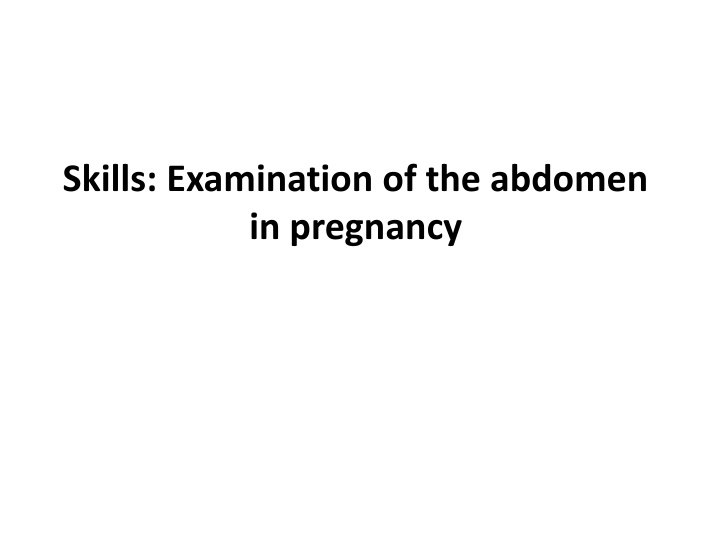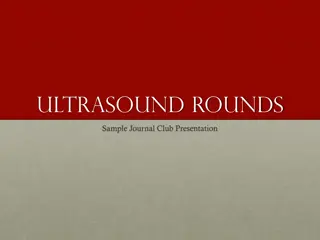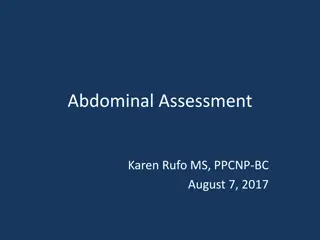Abdominal Examination in Pregnancy: Techniques and Objectives
Examination of the abdomen in pregnancy involves assessing various aspects such as determining gestational age, measuring symphysis-fundus height, evaluating fetal lie and presentation, checking liquor amount, listening to fetal heart sounds, and monitoring fetal movements. The process includes general examination, inspection, fundal palpation, pelvic palpation, and auscultation. Proper preparation, hygiene measures, and respect for privacy are crucial. Fundal height measurement and palpation help determine fetal positioning and wellbeing. Maternal factors like parity and bladder fullness also affect fundal height assessment.
Download Presentation

Please find below an Image/Link to download the presentation.
The content on the website is provided AS IS for your information and personal use only. It may not be sold, licensed, or shared on other websites without obtaining consent from the author.If you encounter any issues during the download, it is possible that the publisher has removed the file from their server.
You are allowed to download the files provided on this website for personal or commercial use, subject to the condition that they are used lawfully. All files are the property of their respective owners.
The content on the website is provided AS IS for your information and personal use only. It may not be sold, licensed, or shared on other websites without obtaining consent from the author.
E N D
Presentation Transcript
Skills: Examination of the abdomen in pregnancy
Objectives Determine the gestational age from the size of the uterus. Measure the symphysis-fundus height. Assess the lie and the presentation of the fetus. Assess the amount of liquor present. Listen to the fetal heart. Assess fetal movements. Assess the state of fetal wellbeing.
General examination of the abdomen There are two main parts to the examination of the abdomen: 1. General examination of the abdomen. 2. Examination of the uterus and the fetus. Abdominal examination The abdominal examination consists of: 1 -Preparation for this 2 -Inspection 3 -Fundalpalpation, 4 -Lateral palpation 5 -Pelvic palpation 6 -Auscultation 7 -Documentation and decision making
Preparation It is important to carry out the usual essential care skills such as: Introduce yourself to the woman Consult the antenatal notes Determine the level of risk and the maternity care needs of the woman Respect hygiene measures and the privacy of the woman.
Inspection The woman s abdomen is inspected for it s shape. This can indicate size and lie of the fetus, the amount of amniotic fluid and sometimes fetal movement may be noticed. Obvious scars will be seen and this information may be significant.
Fundal height Fundal height Is measured to estimate whether this is in keeping with the expected date of birth. This can be done using landmarks i.e. xiphisternum, where the fundal height can be measured by fingerbreadths in relation to this, and the period of gestation is calculated.
Fundal palpation Using the flat interior of the tips of the middle fingers of both hands the fundus is palpated to identify the fetal pole (cephalic or breech). If no pole is located the lie is not longitudinal.
Fundal palpation Fundal palpation is carried out to find out the lie and presentation of the fetus. Things which influence the fundalheight are: maternal parity, size, full bladder, the lie and the number of fetuses. To determine what is found in the fundus a hand is placed on the abdomen below the xiphisternum and gently moved downwards until the fundus is felt.
Fundal palpation Alternatively a measuring tape is used keeping the graduated side downwards so as not to Influence the reader. The antenatal notes are that consulted to see if the growth is normal.
Lateral palpation Lateral palpation assesses the main body of the uterus to confirm the lie and identify the fetal position. The fetal back is usually firmer and more regular in form than the other side of the fetus i.e. the abdomen and the limbs. One hand is placed on one side of the uterus to apply pressure, whilst the other attempts, using the flats of the fingertips, to identify what is found in the opposite side. For example: images on the left demonstrate the practitioner applying pressure, using the left hand, then progressing down the length of the uterus with the right.
Pelvic palpation Pelvic palpation is used to identify the presentation, that is the part of the fetus lying in the lower pole of the uterus, over the pelvic brim. It can be determined whether the fetus is flexed or extended, the presenting part is engaged or not, the presenting part is mobile (ballotable), or engaging To carry out pelvic palpation both hands are used. One hand is placed on either side of the presentation and pressure is applied. The presentation can be felt. It may help if the woman takes a deep breath and blows out. Engagement of the presentation is assessed according to the passage of the widest diameter of the presenting part through the pelvic brim.
Auscultation Locating the fetal presentation and lie will be helpful to show where to place the stethoscope to listen to the fetal heart. The approximate points of fetal heart sounds are shown on the image below.
Auscultation The fetal heart is assessed for its presence, its rate and its regularity. The normal heart rate is between 110 & 150 beats per minute. This is easy to distinguish from the maternal heart rate, which must also be assessed to determine that the fetal heart is actually being listened to. Following the procedure the findings are discussed with the mother and documentation and follow up carried out as appropriate. Records Records of the abdominal examination should include the following features: the fundal height, the lie, presentation and degree of engagement, the position (if identified), the fetal heart rate and whether fetal movements are felt.
A. Preparation of the patient for examination The patient should have an empty bladder. She should lie comfortably on her back with a pillow under her head. She should not lie slightly turned to the side, as is needed when the blood pressure is being taken. B. General appearance of the abdomen The following should be specifically looked for and noted: The presence of obesity. The presence or absence of scars. When a scar is seen, the reason for it should be specifically asked for (e.g. what operation did you have?), if this has not already become clear from the history. The apparent size and shape of the uterus. Any abnormalities.
C. Palpation of the abdomen The liver, spleen, and kidneys must be specifically palpated. Any other abdominal mass should be noted. The presence of an enlarged organ, or a mass, should be reported to the responsible doctor, and the patient should then be assessed by the doctor. Examination of the uterus and the fetus D. Palpation of the uterus Check whether the uterus is lying in the midline of the abdomen. Sometimes it is rotated either to the right or the left. Feel the wall of the uterus for irregularities. An irregular uterine wall suggests either: The presence of myomas (fibroids) which usually enlarge during pregnancy and may become painful. A congenital abnormality such as a bicornuate uterus.
E. Determining the size of the uterus before 18 weeks gestation Anatomical landmarks, i.e. the symphysis pubis and the umbilicus, are used. Gently palpate the abdomen with the left hand to determine the height of the fundus of the uterus: If the fundus is palpable just above the symphysis pubis, the gestational age is probably 12 weeks. If the fundus reaches halfway between the symphysis and the umbilicus, the gestational age is probably 16 weeks. If the fundus is at the same height as the umbilicus, the gestational age is probably 22 weeks (1 finger under the umbilicus = 20 weeks and 1 finger above the umbilicus = 24 weeks).
F. Determining the height of the fundus from 18 weeks gestation The symphysis- fundus height should be measured as follows: 1. Feel for the fundus of the uterus. This is done by starting to gently palpate from the lower end of the sternum. Continue to palpate down the abdomen until the fundus is reached. When the highest part of the fundus has been identified, mark the skin at this point with a pen. If the uterus is rotated away from the midline, the highest point of the uterus will not be in the midline but will be to the left or right of the midline. Therefore, also palpate away from the midline to make sure that you mark the highest point at which the fundus can be palpated. Do not move the fundus into the midline before marking the highest point.
2. Measure the symphysis-fundus (SF) height. Having marked the fundal height, hold the end of the tape measure at the top of the symphysis pubis. Lay the tape measure over the curve of the uterus to the point marking the top of the uterus. The tape measure must not be stretched while doing the measurement. Measure this distance in centimetres from the symphysis pubis to the top of the fundus. This is the symphysis-fundus height.
12 weeks Uterus is just about the symphysis pubis 18 weeks Uterus half way between the symphysis pubis and umbilicus 20 weeks above the half way but 2.5 cms below the umbilicus 24 weeks fundus will be present at the upper margin of the umbilicus about 20 cms from the symphysis pubis or 3 finger breadth above 20 weeks. 28 weeks fundus is 1/3rd from the umbilicus to the xiphisternum or 30 cms from the symphysis pubis approximately. 32 weeks 2/3rd distance from the umbilicus and xiphisternum, 6 finger above the umbilicus 36 weeks 3/3rd distance, which means at the level of xiphisternum approximately 35 cms or 13-14 inches 40 weeks mostly lightening takes place and uterus descends down to the level of 32 wks.
Sometimes fundal height does not correspond with period of gestation and the reasons could be: i) Multiple pregnancy ii) Polyhydramnios iii) Foetal macrosomias iv) Big baby v) Wrong dates If the fundal height is less than the period of gestation then it could be due to: i) Abnormal foetal presentation ii) Growth retarded foetus iii) Congenital malformations iv) Oligohydramnios v) IUD (Intrauterine Death) vi) Wrong dates Observe for lightening if it has occurred. Observe for presenting part if it has settled in the pelvis. At this time the fundal height decreases.
G. Palpation of the fetus The lie and presenting part of the fetus only becomes important when the gestational age reaches 34 weeks. The following must be determined: The lie of the fetus. This is the relationship of the long axis of the fetus to that of the mother. The lie may be longitudinal, transverse, or oblique. The presentation of the fetus. This is determined by the presenting part: If there is a breech, it is a breech presentation. If there is a head, it is a cephalic presentation. If no presenting part can be felt, it is a transverse or oblique lie. The position of the back of the fetus. This refers to whether the back of the fetus is on the left or right side of the uterus, and will assist in determining the position of the presenting part.
H. Methods of palpation There are four specific steps for palpating the fetus. These are performed systematically. With the mother lying comfortably on her back, the examiner faces the patient for the first three steps, and faces towards her feet for the fourth. The four steps in palpating the fetus First step. Having established the height of the fundus, the fundus itself is gently palpated with the fingers of both hands, in order to discover which pole of the fetus (breech or head) is present. The head feels hard and round, and is easily movable and ballotable. The breech feels soft, triangular and continuous with the body.
Second step. The hands are now placed on the sides of the abdomen. On one side there is the smooth, firm curve of the back of the fetus, and on the other side, the rather knobbly feel of the fetal limbs. It is often difficult to feel the fetus well when the patient is obese, when there is a lot of liquor, or when the uterus is tight, as in some primigravidas. Third step. The examiner grasps the lower portion of the abdomen, just above the symphysis pubis, between the thumb and fingers of one hand. The objective is to feel for the presenting part of the fetus and to decide whether the presenting part is loose above the pelvis or fixed in the pelvis. If the head is loose above the pelvis, it can be easily moved and balloted. The head and breech are differentiated in the same way as in the first step.
Fourth step. The objective of this step is to determine the amount of head palpable above the pelvic brim in fifths, if there is a cephalic presentation. The examiner faces the patient s feet, and with the tips of the middle 3 fingers palpates deeply in the pelvic inlet. In this way the head can usually be readily palpated, unless it is already deeply in the pelvis. The amount of the head palpable above the pelvic brim can also be determined
I. Special points about the palpation of the fetus 1. When you are palpating the fetus, always try to assess the size of the fetus itself. Does the fetus fill the whole uterus, or does it seem to be smaller than you would expect for the size of the uterus and the duration of pregnancy? A fetus which feels smaller than you would expect for the duration of pregnancy, suggests intra-uterine growth restriction, while a fetus which feels smaller than expected for the size of the uterus, suggests the presence of a multiple pregnancy. 2. If you find an abnormal lie when you palpate the fetus, you should always consider the possibility of a multiple pregnancy. When you suspect that a patient might have a multiple pregnancy, she should have an ultrasound examination.
J. Special points about the palpation of the fetal head Does the head feel too small for the size of the uterus? You should always try to relate the size of the head to the size of the uterus and the duration of pregnancy. If it feels smaller than you would have expected, consider the possibility of a multiple pregnancy. Does the head feel too hard for the size of the fetus? The fetal head feels harder as the pregnancy gets closer to term. A relatively small fetus with a hard head suggests the presence of intra-uterine growth restriction. K. Assessment of the amount of liquor present This is not always easy to feel. The amount of liquor decreases as the pregnancy nears term. The amount of liquor is assessed clinically by feeling the way that the fetus can be moved (balloted) while being palpated.
1- If the liquor volume is reduced (oligohydramnios), it suggests that: There may be intra-uterine growth restriction. The possibility that the membranes have ruptured needs to be considered. There may be a urinary tract obstruction or some other urinary tract abnormality in the fetus. This is uncommon. 2- If the liquor volume is increased (polyhydramnios), it suggests that one of the following conditions may be present: Multiple pregnancy. Maternal diabetes. A fetal abnormality such as spina bifida, anencephaly or oesophageal atresia.
In many cases, however, the cause of polyhydramnios is unknown. However, serious problems can be present and the patient should be referred to a hospital where the fetus can be carefully assessed. The patient needs an ultrasound examination by a trained person to exclude multiple pregnancy or a congenital abnormality in the fetus.
L. Assessment of uterine irritability This means that the uterus feels tight, or has a contraction, while being palpated. Uterine irritability normally only occurs after 36 weeks of pregnancy, i.e. near term. If there is an irritable uterus before this time, it suggests either that there is intra-uterine growth restriction or that the patient may be in, or is likely to go into, preterm labor.
M. Listening to the fetal heart 1. Where should you listen? The fetal heart is most easily heard by listening over the back of the fetus. This means that the lie and position of the fetus must be established by palpation before listening for the fetal heart. 2. When should you listen to the fetal heart? You need only listen to the fetal heart if a patient has not felt any fetal movements during the day. Listening to the fetal heart is, therefore, done to rule out an intra-uterine death. 3. How long should you listen for? You should listen long enough to be sure that what you are hearing is the fetal heart and not the mother s heart. When you are listening to the fetal heart, you should, at the same time, also feel the mother s pulse.
N. Assessment of fetal movements The fetus makes two types of movement: 1. Kicking movements, which are caused by movement of the limbs. These are usually quick movements. 2.Rolling movements, which are caused by the fetus changing position. When you ask a patient to count her fetal movements, she must count both types of movement.
If there is a reason for the patient to count fetal movements and to record them on a fetal-movement chart, it should be done as follows: Time of day. Most patients find that the late morning is a convenient time to record fetal movements. However, she should be encouraged to choose the time which suits her best. She will need to rest for an hour. It is best that she use the same time every day. Length of time. This should be for 1 hour per day, and the patient should be able to rest and not be disturbed for this period of time. Sometimes the patient may be asked to rest and count fetal movements for 2 or more half-hour periods a day. The patient must have access to a watch or clock, and know how to measure half- and 1-hour periods.
3. Position of the patient. She may either sit or lie down. If she lies down, she should lie on her side. In either position she should be relaxed and comfortable. 4. Recording of fetal movements. The fetal movements should be recorded on a chart as shown in Table Table 1: Chart for recording fetal movements Date Time Total 3 July 8 9 6 4 July 11 12 9 5 July 8 9 3
The chart records that: Between 08:00 and 09:00 on 3 July the fetus moved 6 times. Between 11:00 and 12:00 on 4 July the fetus moved 9 times. Between 08:00 and 09:00 on 5 July the fetus moved 3 times. Every time the fetus moves, the patient must make a tick on the chart so that all the movements are recorded. The time and day should be marked on the chart. If the patient is illiterate, the nurse giving her the chart can fill in the day (and times if the chart is to be used more than once a day). It is important to explain to the patient exactly how to use the chart. Remember that a patient who is resting can easily fall asleep and, therefore, miss fetal movements.
O. Assessment of the state of fetal wellbeing It is very important to assess the state of fetal wellbeing at the end of every abdominal palpation. This is done by taking into account all the features mentioned in this skills.























